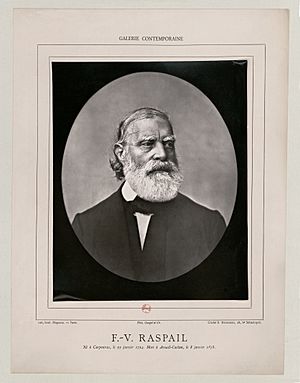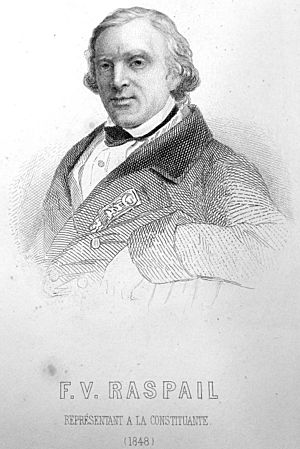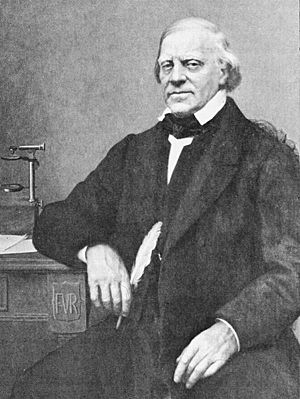François-Vincent Raspail facts for kids
François-Vincent Raspail (born January 25, 1794 – died January 7, 1878) was a very smart and active French person. He was many things: a chemist, a naturalist (someone who studies nature), a physician (doctor), and a physiologist (someone who studies how living things work). He was also a lawyer and a socialist politician, meaning he believed in fairness and equality for everyone.
Contents
Life and Times of François-Vincent Raspail
François-Vincent Raspail was born in a town called Carpentras in France. He was part of a group called the Carbonari, which worked for republican ideas (where people elect their leaders). He was also a Freemason. Through these groups, he met other important people like François Arago and Victor Schoelcher.
Raspail faced challenges because of his political beliefs. He was put in prison during the time of King Louis Philippe (1830–1848). He even ran for president of the Second Republic in December 1848. However, he was involved in a protest in May 1848 and was imprisoned again in 1849.
Later, his prison sentence was changed to exile, meaning he had to leave France. He returned to France in 1862. In 1869, he was elected as a representative for Lyons. He remained a well-liked republican during the French Third Republic, even after the short-lived Paris Commune in 1871.
Raspail passed away in Arcueil.
His sons, Benjamin Raspail, Camille Raspail, Émile Raspail, and Xavier Raspail, also became important figures. His daughter, Marie Raspail, was a strong supporter of her father. She cared for him while he was a political prisoner and sadly became ill herself, leading to her death.
Raspail's Scientific Discoveries
Raspail was one of the people who helped start the cell theory in biology. This theory explains that all living things are made of cells. He even came up with the famous saying omnis cellula e cellula, which means "every cell comes from a cell that was already there." This idea was later made famous by Rudolf Karl Virchow.
He was also one of the first to use a microscope to study plants. This helped scientists see tiny details they couldn't see before. Raspail also believed in using antiseptics (things that kill germs) and having better cleanliness and healthy food. His book, "Manuel annuaire de la santé 1834," is even shown in a famous painting by Vincent van Gogh called "Still life with a plate of onions" (1889).
Raspail's Start in Politics
After the revolution of 1830, Raspail became very active in politics. He became the President of the Human Rights Society. Because of this role, he was put in prison. While in prison, he helped sick inmates and studied their illnesses. He became convinced that camphor could help. He thought it worked by killing tiny parasites, which was an early idea similar to the germ theory of disease.
Later Political Career
Raspail ran for President of the French Second Republic in December 1848. He came in fourth place, losing to Louis-Napoléon Bonaparte. He was involved in a protest on May 15, 1848, and was imprisoned again in March 1849. In 1853, his prison sentence was changed to exile by Napoleon III.
He returned to France from exile in 1862. In 1869, he was elected as a representative for Lyon, and in 1875, for Marseille. He remained a popular and respected figure during the French Third Republic. A long street in Paris, Boulevard Raspail, was named in his honor. The Raspail Métro station also takes its name from this boulevard.
See also
 In Spanish: François Vincent Raspail para niños
In Spanish: François Vincent Raspail para niños
- French demonstration of 15 May 1848




